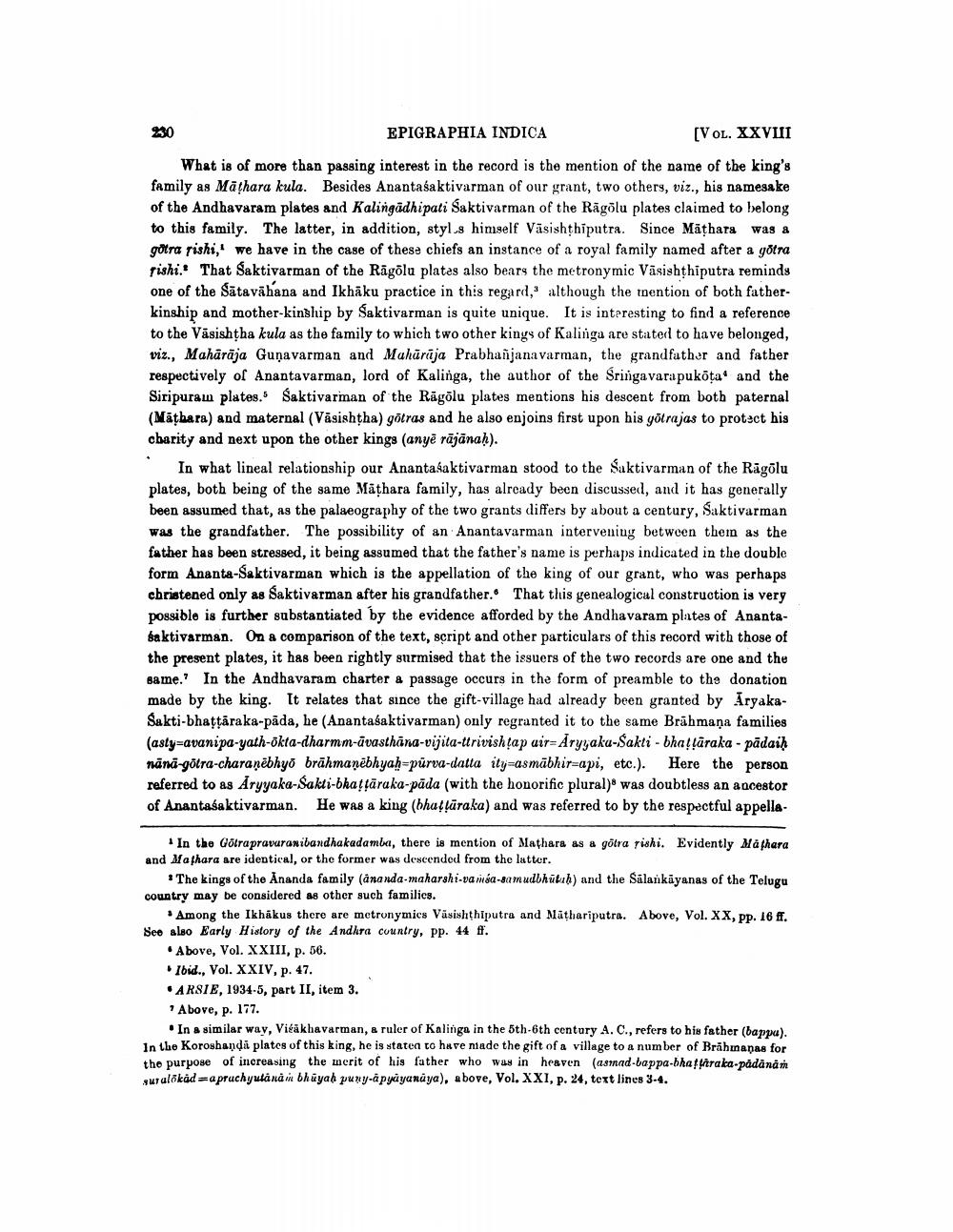________________
30 EPIGRAPHIA INDICA
[VOL. XXVIII What is of more than passing interest in the record is the mention of the name of the king's family as Māthara kula. Besides Anantaśaktivarman of our grant, two others, viz., his namesake of the Andhavaram plates and Kalingadhipati Saktivarman of the Rägölu plates claimed to belong to this family. The latter, in addition, styl s himself Väsishthiputra. Since Māthara was a götra rishi,! we have in the case of these chiefs an instance of a royal family named after a yotra rishi. That Saktivarman of the Rāgõlu plates also bears the metronymic Väsishthiputra reminds one of the Sātavāhana and Ikhāku practice in this regard, although the tnention of both fatherkinship and mother-kinship by Saktivarman is quite unique. It is interesting to find a reference to the Väsishtha kula as the family to which two other kinys of Kalingu are stated to have belonged, viz., Mahārāja Gunavarman and Mahārīja Prabhanjanavarman, the grandfather and father respectively of Anantavarman, lord of Kalinga, the author of the Sringa varapukota" and the Siripuram plates. Saktivarman of the Rāgõlu plates mentions his descent from both paternal (Mätbara) and maternal (Vāsishtha) gotras and he also enjoins first upon his yötrajas to protect his charity and next upon the other kings (anyē rājānah).
In what lineal relationship our Ananta aktivarman stood to the Saktivarman of the Rāgõlu plates, both being of the same Māthara family, has already been discussed, and it has generally been assumed that, as the palaeography of the two grants differs by about a century, Saktivarman was the grandfather. The possibility of an Anantavarman intervening between them as the father has been stressed, it being assumed that the father's name is perhaps indicated in the double form Ananta-Saktivarman which is the appellation of the king of our grant, who was perhaps christened only as Saktivarman after his grandfather. That this genealogical construction is very possible is further substantiated by the evidence afforded by the Andhavaram plates of Anantabaktivarman. On a comparison of the text, script and other particulars of this record with those of the present plates, it has been rightly surmised that the issuers of the two records are one and the same. In the Andhavaram charter a passage occurs in the form of preamble to the donation made by the king. It relates that since the gift-village had already been granted by AryakaSakti-bhattāraka-pāda, he (Anantasaktivarman) only regranted it to the same Brāhmaṇa families (asty=avanipa-yath-okta-dharmm-āvasthana-vijita-ttrivishtap air=Aryaku-Sakti - bhattāraka - pādaih nana-gotra-charaņēbhyo brāhmanēbhyah-pürva-datta ity=asmābhir-api, etc.). Here the person referred to as Aryyaka-Sakti-bhagfāraka-pāda (with the honorific plural) was doubtless an ancestor of Anantasaktivarman. He was a king (bhatļūraka) and was referred to by the respectful appella
In the Götra pravuranibandhakadamba, there is mention of Mathara as a götra rishi. Evidently Mathara and Mathara are identical, or the former was descended from the latter.
The kings of the Ananda family (ananda-maharshi-variiba-samudbhūluh) and the Sálarkāyanas of the Telugu country may be considered as other such families.
Among the Ikhākus there are metronymics Väsishthiputra and Mathariputra. Above, Vol. XX, pp. 16 ff. See also Early History of the Andhra country, pp. 44 ff.
. Above, Vol. XXIII, p. 56.
Ibid., Vol. XXIV, p. 47. • ARSIE, 1934-5, part II, item 3. * Above, p. 177.
. In a similar way, Vitakhavarman, a ruler of Kalinga in the 5th-6th century A. C., refers to his father (bappu). In the Koroshandi plates of this king, he is statea to have niade the gift of a village to a number of Brahmanas for the purpose of increasing the merit of his father who was in heaven (asmad-bappa-bhaffraka-padanan sur alokád=apruchyuta náin bhūyah puny-apyāyanaya), above, Vol. XXI, p. 24, text lines 3-4.




